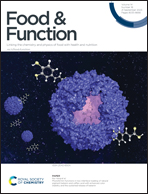Germinated chickpea protein ficin hydrolysate and its peptides inhibited glucose uptake and affected the bitter receptor signaling pathway in vitro†
Abstract
The objective of this study was to evaluate germinated chickpea protein hydrolysate (GCPH) in vitro for its effect on markers of type 2 diabetes (T2D) and bitter taste receptor expression in intestinal epithelial cells. Protein hydrolysate was obtained using ficin, and the resulting peptides were sequenced using LC-ESI-MS/MS. Caco-2 cells were used to determine glucose uptake and extra-oral bitter receptor activation. Three peptides, VVFW, GEAGR, and FDLPAL, were identified in legumin. FDLPAL was the most potent peptide in molecular docking studies with a DPP-IV energy of affinity of −9.8 kcal mol−1. GCPH significantly inhibited DPP-IV production by Caco-2 cells (IC50 = 2.1 mM). Glucose uptake was inhibited in a dose-dependent manner (IC25 = 2.0 mM). A negative correlation was found between glucose uptake and PLCβ2 expression in Caco-2 cells (R value, −0.62). Thus, GCPH has the potential to be commercialized as a functional ingredient.



 Please wait while we load your content...
Please wait while we load your content...